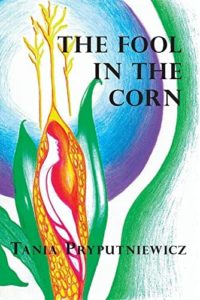Tania Pryputniewicz makes sense of an unusual childhood
Tania Pryputniewicz had an unusual childhood. Her father accidentally overdosed after unknowingly drinking an LSD-laced cup of punch at a party in San Francisco. Her parents decide to make a clean break with their current life; the family ended up on the prairies of Illinois, in a town called Stelle. They had become part of the Chosen, a commune led by a self-styled messiah called “the Leader” who preached an imminent apocalypse. But the apocalypse never came, and the messiah turned out to be something of a predator.
Eventually, they returned to California, with a hope for some kind of normal life and saving her parents’ marriage. The life became more normal, but the marriage couldn’t be saved.
Half a century later, Pryputniewicz has written The Fool in the Corn: Poems. The collection is divided into five sections with geographic headings: Illinois, California I, Iowa, California II, and California III. The geography changes, but the poems are all about searching for place and making sense of that childhood with the Chosen. Intentionally or not, Pryputniewicz makes the case for how important, and how formative, childhood is and how it shapes and influences all of what comes after.
The poems follow the trajectory of the poet’s life, through childhood, university, embarking upon a writing career, and marriage and her own family. She’s reached the time when many of us, perhaps most of us, begin to take stock of our lives, our families and forebears, the people who shaped us, the events that changed us. Pryputniewicz remembers a ride on the Ferris wheel at that most commonplace event of rural life, the county fair.
County Fair

not a Messiah.
Holding my brother’s hand in line,
I wonder if others see what I see.
Ticket bought, we mount the spoked wheel,
distracted by colored bulbs, mesh seat, chilled rims
of my ears
and the view
of the linear order of corn from the sky.
One more pass to touch the field
and up we go, a fraction closer to the stars
on our controlled and momentary arc of ascent.
By the time my body lets go
into the centrifugal force,
free of earth’s gravity, we descend
past our mothers — lined up
as if for the Leader,
ready to hurtle sideways,
like Chagall’s brides,
bouquets in hand, upturned faces rouged,
veils peeled and tucked behind their heads.

Tania Pryputniewicz
Pryputniewicz has previously published the poetry collections November Butterfly (2014) and Heart’s Compass Tarot: Discover Tarot Journaling and Create Your Own Cards (2021). Her poems have been published in numerous literary journals and magazines. She is a graduate of the Iowa Writers’ Workshop, and she teaches poetry and tarot-inspired writing classes for San Diego Writers, Ink, Antioch University’s Continuing Education Program, and private courses through her website. She lives in California with her family.
A Fool in the Corn ends with a prose poem, a letter written to that 8-year-old girl transplanted from California to rural Illinois, the one who suspected the Leader was a charlatan and who found solace reading Nancy Drew mysteries by the upstairs farmhouse window. And she confesses that she still enjoys reading Nancy Drew mysteries.
Photo by Bethan, Creative Commons, via Flickr. Post by Glynn Young.
How to Read a Poem uses images like the mouse, the hive, the switch (from the Billy Collins poem)—to guide readers into new ways of understanding poems. Anthology included.
“I require all our incoming poetry students—in the MFA I direct—to buy and read this book.”
—Jeanetta Calhoun Mish
- Poets and Poems: Lisa Marie Basile and “Saint Of” - April 29, 2025
- Poets and Poems: Sandra Marchetti and “Diorama” - April 24, 2025
- Poets and Poems: Christina Cook and “Roaming the Labyrinth” - April 22, 2025


Leave a Reply